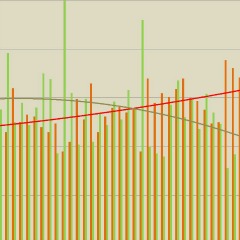Open Access in a nutshell
On this site you can read about further reasons to go Open Access, describing the difference between publishing in an Open Access journal and archiving in an Open Access repository.
Moreover you will find information about what to consider and do if you plan to publish in an Open Access journal. A short introduction will also help you to find the proper repository to archive your papers.
Why publish Open Access?

“The basic idea of Open Access is simple: Make research literature available online without price barriers and without most permission barriers.”
Peter Suber, Open Access (the book)
For several decades, the scientific community has been facing more and more disproportionate cost increases from many scholarly journals. The reasons for this so-called “serial crisis” are complex, but an essential factor is the quasi-monopoly of several publishers. Scientists, working in the environment of financially secure research institutes, often do not face the problem directly. However the visibility, re-use and impact of their scientific research suffer from the limitation of access by price-barriers. Through this lens, it is clear that open access to research results should be enforced.
There are various ways to provide online open access to research results. Some scientists already make their publications accessible on their private web pages. This is a good first step. Several additional strategies offer a remedy for restricted access:
Publishing in an Open Access journal?
For a research publication, the most certain strategy for making work openly accessible is to publish in a peer-reviewed Open Access journal. An increasing number of initiatives like the Public Library of Science (PLoS) or BioMed Central offer a system of charge-free access to publications and open licenses of content. Emerging costs have to be paid once by the author or, in most cases, by the author´s employer. This so-called “Gold Open Access” in return guarantees unlimited online access from anywhere to the original publication.
For further information on publishing in an Open Access journal, please visit Open Access Gold or contact the library team.
Archiving in a Repository?
Even if an article first appears in a journal or conference following the classic subscription model, there is – in most cases – still a chance to make a copy of it freely available. For this reason, different repositories for scientific works have been established over the years. Subject repositories, on the one hand, cover certain research areas, e.g. arXiv in the field of physics and mathematics. On the other hand research institutions like ISTA collect their researchers’ publications in institutional repositories. The use of one does not preclude the use of the other, rather using both increases visibility. Conventional publishers limit the republishing of works: however, preprints, postprints, working papers or technical reports are still often free of these restrictions. Even the original works can often be uploaded to a repository after a period of time, as the last submitted version. This depends on the policy of the publisher and the journal.
For further information on publishing in a repository visit Open Access Green or please contact the library team.
How to publish Open Access?
There are two major strategies on the road to Open Access:
On the one hand, scientists can decide to publish their work in an Open Access journal, which provides unlimited access to publication from anyone and anywhere. This elegant solution is also called the “Golden Way to Open Access”. You can find more details about how to publish in an Open Access journal including information on Impact Factor and questionable Open Access journals in Open Access Gold.
On the other hand, it is also possible to make your work openly accessible, even if you already published it in a conventional journal. For this, subject and institutional repositories have been developed, where you can upload pre-prints, post-prints, working papers etc. of your work. This self-archiving strategy is also called the “Green Way to Open Access”. You can find more information about how and where to archive your publications at Open Access Green.
If you need help in choosing which way to follow, do not hesitate to contact the library team.
Watch the corresponding video on YouTube
Gold Open Access
How to publish in an Open Access journal?

If you decide to publish in an Open Access journal, you have to find a suitable journal for your paper. To do so, visit the Directory of Open Access Journals (DOAJ) where nearly 10.000 journals for all kinds of subjects are listed and described.
Some criteria will be essential for finding the right journal for your paper.
One of the major issues scientists are facing is the impact factor of journals. Since Open Access journals usually do not look back on a long tradition, they often struggle to be accepted in the scientific community. However, studies are showing that, for instance, journals indexed in Web of Science or Scopus may approach the same scientific impact and quality as subscription-based journals.
A further question concerns creative commons licenses: Some Open Access journals will act more liberally and use a CC-BY license, which means that it is possible to share, remix and commercially use the publication. Some publishers and journals tend to employ more restrictive open licenses. A CC-BY-NC license still allows the public community to share and remix the work, but commercial use is prohibited. A CC-BY-NC-ND license will not let you alter, transform or build upon the work, but it´s still free to share the publication. Furthermore, there are journals offering unlimited Open Access without open licenses.
An essential criterion for publishing Open Access is the financing of the publication. Open Access usually does not mean free of charge as publishing still generates costs. Some peer-reviewed journals are subsidized, and some will charge publication fees. But article processing charges (APCs) do not automatically mean that authors have to pay out of their own pocket. Funders often share publication costs; this may also be the case at ISTA.
At the DOAJ website, you will receive information concerning licenses and publication costs of all Open Access journals. If you find a suitable journal for your needs, you can submit a manuscript in the same way as you would to a conventional journal.
For further questions on publishing in Open Access journals, please contact the library team.
Impact factor of Open Access journals

The impact factor (IF) is a measure for academic journals, which reflects the average number of citations of articles published in a certain journal. Scientists can thereby compare the influence of different journals within a certain field. Efficiency and visibility are essential for the reputation of scientists: higher publicity often promotes careers.
Open Access journals still struggle for reputation within the scientific community, although some already achieve higher IF-values than “conventional” journals. Studies have also shown that articles with free access on average have higher citation rates than ones appearing in journals with restricted access. But not only citation rates and impact factors are essential for the evaluation of journals. Download rates for articles are a useful measure of the visibility of scientific results. It´s clear that articles with Open Access have a much better chance to be downloaded, read and used. Hence they are more integrated in the circulation of scientific communication.
Questionable Open Access journals
“A negative consequence of the rapid growth of scholarly open access publishing funded by article processing charges is the emergence of publishers and journals with highly questionable marketing and peer review practices. These so-called predatory publishers are causing unfounded negative publicity for open access publishing in general.” © 2015 Shen and Björk.
“Predatory” Open Access publishing is defined as a business model of publishing that charges publication fees (APCs) as most of “Gold” Open Access journals do, without providing proper peer review. They pretend to be serious journals despite a lack of editorial and publishing services.
Although its not always easy to draw the line between serious and pseudo-journals some tools can help you to find out, if a journal is trustworthy or not:
- The Directory of Open Access Journals goes to great lengths to filter out questionable journals, only trustworthy ones should be listed here.
- Go through the list of Chrissy Prater.
- Possibly the most sufficient way to find out if an Open Access journal meets your scientific expectations is to check the quality of some of their articles by skip-reading them.
If you are not sure about the quality of a journal please contact the library team for further information and guidance.
Green Open Access
How to archive in a repository?

If you are planning to publish your paper in a conventional journal without Open Access, you often still have the chance to place the results of your research in a repository. This way, your work gains visibility, becomes reachable for everybody with online access, and promotes re-use and citation.
Repositories make use of the fact that while publishers employing the classic subscription model restrict the spread of articles published in their journals, they often still allow making pre-prints, post-prints, working papers or technical reports accessible. At some journals, it is also possible to upload the last submitted version of a paper after a period of time. To find out more about permissions normally given as part of each publisher’s copyright transfer agreement, visit SHERPA /RoMEO. Here you can search for your publishing journal and your rights to archive your pre-print, post-print, embargo times etc.
Mainly, there are two different sorts of repositories that you can choose between:
So called subject repositories specialize in the dissemination of specific fields of science. An example of such an extensive subject repository is arXiv.org, holding more than 900.000 e-prints mainly in physics, mathematics, computer science and quantitative biology. Several scientists at ISTA have already uploaded numerous pre- or post-prints onto one of the platforms. If you are still looking for an appropriate subject repository, have a look at OpenDOAR, an authoritative directory of quality-controlled academic Open Access repositories.
Institutional repositories have been established to provide Open Access to institutional research output and to enhance the visibility of an institution’s scholarly research. More and more universities and research institutes are following the idea of storing and preserving their research results, independent of restrictions by publishers. ISTA also offers the service of reliable archiving for its scientists. Please visit our ISTA Research Explorer.
If you are planing to make use of the ISTA repository, or you need help in finding a suitable subject repository, please feel free to contact the library team.
OA publication repositories used by researchers at ISTA:
ISTA Research Explorer
arXiv
PubMed Central
Cryptology ePrint Archive


